

/#/. How I Teach. Every Single Cognitive Bias in One Infographic. UIEtips: 5 Indispensable Skills of UX Mastery. By Jared Spool August 3rd, 2010 A few weeks back, I watched a conversation on the Interaction Design Association’s (IxDA) discussion list that tried to assess whether one can call themselves a designer if they can’t draw.
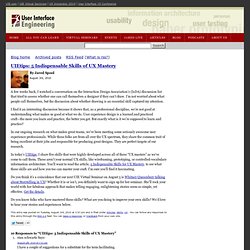
I’m not worried about what people call themselves, but the discussion about whether drawing is an essential skill captured my attention. I find it an interesting discussion because it shows that, as a professional discipline, we’re not good at understanding what makes us good at what we do. User experience design is a learned and practiced craft—the more you learn and practice, the better you get.
In our ongoing research on what makes great teams, we’ve been meeting some seriously awesome user experience professionals. In today’s UIEtips, I share five skills that were highly developed across all of these “UX masters” as we’ve come to call them. User Interface Design and UX Design: 80+ Important Research Papers Covering Peer-Reviewed and Informal Studies. Important peer-reviewed and informally published recent research on user interface design and user experience (UX) design.
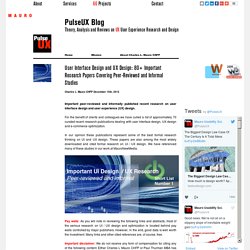
For the benefit of clients and colleagues we have culled a list of approximately 70 curated recent research publications dealing with user interface design, UX design and e-commerce optimization. In our opinion these publications represent some of the best formal research thinking on UI and UX design. These papers are also among the most widely downloaded and cited formal research on UI / UX design.
We have referenced many of these studies in our work at MauroNewMedia. Capturing User Research. Recording Video You should record video whenever it’s important for you to be able to review the visual elements of your user research sessions.
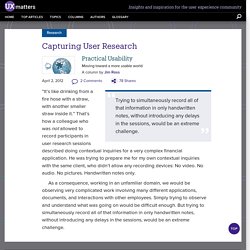
For example, in usability testing, contextual inquiries, and ethnographic observations, it’s important to see participants’ actions. For other research activities such as interviews, the visual element is less important, so audio recordings are sufficient. Video also gives you a powerful way of allowing others to experience your user research. Although you can report your findings in words, it’s often much more impactful for your audience to see and hear research participants by watching video clips. So, if video provides the benefit of capturing both the audio and visual elements of research sessions, why not capture video all the time? Story Mapping Example Problems - Jeff Patton & Associates. I have a fundamental problem when teaching Story Mapping in a class or workshop.
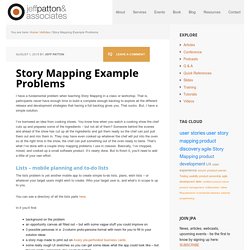
That is, participants never have enough time to build a complete enough backlog to explore all the different release and development strategies that having a full backlog gives you. That sucks. But, I have a simple solution. I’ve borrowed an idea from cooking shows. When to Use Which User-Experience Research Methods. The field of user experience has a wide range of research methods available, ranging from tried-and-true methods such as lab-based usability studies to those that have been more recently developed, such as unmoderated online UX assessments.
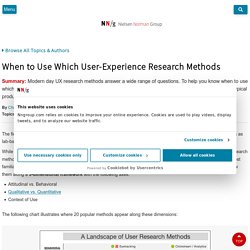
While it's not realistic to use the full set of methods on a given project, nearly all projects would benefit from multiple research methods and from combining insights. Unfortunately many design teams only use one or two methods that they are familiar with. The key question is what to do when. To better understand when to use which method, it is helpful to view them along a 3-dimensional framework with the following axes: Attitudinal vs. The following chart illustrates where 20 popular methods appear along these dimensions: Don’t ask users what they want! - axbom. One of the most common mistakes organizations make is to ask users what they want.

The problem with this is that users are lousy at knowing what they want. Never Ask What They Want — 3 Better Questions to Ask in User Interviews — User Research. The first rule of user research: never ask anyone what they want. — Erika Hall, Just Enough Research I rave about user interviews.

They’re cheap (see: free), potent (you get more than what you ask for), and efficient (you only really need to talk to five people). But good interviewing takes practice. ARCHEWORKS - MMO Game UX UI Redesign Case Study & what I've learned - BuiltbyG - Blog about Web & Graphic Design. This is the story behind my “viral” MMO game UX UI redesign project and what I’ve learned from it.

I had some free time during the holidays and thus I decided to redesign the Guild Wars 2 UI & Official website which is a MMO (Massive Multiplayer Online) since I felt it could do with some improvements in the UX UI department. About the UX UI redesign project: The project was tackled in my free time during multiple weeks, as a way to diversify my portfolio and do something new that I haven’t done in a while. I choose this specific game since I was already familiar with it and it’s also a MMO which involves tons of users that would interact with it on a daily basis, similar to how a web app has thousand of users.
Research & Testing: Since this was a personal project I did have some creative freedom when it came to the approach, unfortunately data gathering & user testing was quite limited due to not having the resources and technology the developers have. Design Thinking for Educators. UXPrinciples.com. Announcing Winners in the International Design for Experience Awards. We are thrilled to be able announce winners in the inaugural international Design for Experience awards.

Presented by UX Magazine, the DfE awards recognize excellence in all aspects of experience design and the winners in each category were chosen in large part based on what the UX community can learn from their achievements. Academic Program. Human Factors of Computer Interface Design. Why Design, Why ID + Why Now? The world is growing more complex every day.
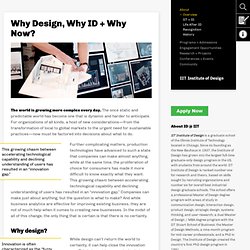
The once static and predictable world has become one that is dynamic and harder to anticipate. For organizations of all kinds, a host of new considerations—from the transformation of local to global markets to the urgent need for sustainable practices—now must be factored into decisions about what to do. This growing chasm between accelerating technological capability and declining understanding of users has resulted in an “innovation gap. " Further complicating matters, production technologies have advanced to such a state that companies can make almost anything, while at the same time, the proliferation of choice for consumers has made it more difficult to know exactly what they want.
50 Sketching Resources for User Experience Designers. Sketching is a critical part of the User Experience Design process. Sketching allows us to explore ideas and iterate on concepts quickly and easily before creating detailed mockups. Below is a roundup of many different sketching articles, tools, templates, presentations, videos, books, and examples to help User Experience Designers learn more about sketching and how it benefits UX design. RSA Shorts - The Power of Empathy. Learner Experience. UX Career Development. I volunteered to be a part of the UXPA 2014 conference organizing team. I am helping Alberta Soranzo with the "Career development" topic, which means I will be part of a team that encourages submissions, manages reviews, and helps form this part of the program.
I need your help! Read over the Career Development topic description and consider submitting something. The deadline is January 31st. Note that there are many types to choose from, such as presentations, panel, posters, and tutorials.Help spread the word to others. Cognitive Perception: Gestalt Principles flashcards. Human Computer Interaction - brief intro. Visual Definitions of User Experience.
School of Information and Library Science. Industrial design magazine + resource / Articles Archive. Core77 Design Awards 2012: Congratulations to All 200+ Awardees! From Paris to Brasília, Seoul to San Francisco, Chengdu to Brooklyn, we hope you enjoyed tuning into our global celebration of design excellence! Thanks to all those who participated in this year's program and a special thank you to our jury teams who had the tremendous job of reviewing this year's submissions—we couldn't have done it without you!
Case Study: Outlier on Creating the 21st Century Jean. Jon Kolko » Now Hiring: The Most Liberal Art. When most of us think of the word "design"—if we think of it at all—we imagine eccentric fashion, or expensive plastic toasters, or shiny new cars. That's because America has long celebrated objects. We're a culture that, for nearly a century, has enjoyed the convenience and status of owning things. Our economy has been driven by the production of things, our government measures progress based on the average cost of things, and things give us a visceral and obvious measure of success. But our world has changed, and things no longer represent a strong measure of success or target for our efforts.
From a business perspective, producing things is largely a march towards "commodity hell," where competitive offshore manufacturing massively undercuts profit. Jon Kolko » Design strategy, product management, education & writing. HCI Education Survey. Thank you for participating in this survey for the ACM SigCHI special project on HCI education needs. This survey is grounded in previous research. Between March and August of 2011, exploratory research was conducted with 177 survey participants and 52 interview participants. Data from this exploratory research was iteratively coded to identify overarching themes for further exploration. These themes generated the questions that you will answer below. The survey is broken down into five sections that are each one page in length. Survey results will be posted to and emailed to participants who provide an email address.
ACM SIGCHI Curricula for Human-Computer Interaction : 4. HCI Curriculum Designs. Master of Science in Human Centered Design & Engineering. Electrical Engineering and Computer Science. Home - UW HCDE 518. What Is Design If Not Human-Centered? The explosive growth of interest in human-centered design raises bigger questions about traditional design education, training, and practice. Late last week, IDEO.org—the nonprofit spinoff of design and strategy giant IDEO—announced a first-of-its-kind, five-week, experiential training program in the art and science of Human-Centered Design for Social Innovation. The program is run in partnership with +Acumen, the outreach arm of social impact investment pioneers, Acumen. The partnership is only the most recent example of design infiltrating—or at least influencing—the philanthropic and social sectors. Human-centered design expressly involves the investigation of social problems, analysis of knowledge, engagement of users, and prototyping or iteration of solutions.
At the heart is a focus on actual users, achieved via interviews, observation, and good old-fashioned listening. Human-Centered Design Course Thread Bibliography. Human-Centered Design Course Thread Bibliography. The UX of Learning. While many desk-shackled students may wish they were napping rather than enduring yet another monotonous lecture, learning is by no means confined within the classroom. In fact, we engage in focused learning activities every day.
Think of the last time you ordered a book, booked a flight, or bought a car. How did you choose which book to read, where to go for vacation, or which car was best for you? You may have searched online, read reviews, or asked others for advice to help you make an informed decision. In a word, you learned. Learning to See.